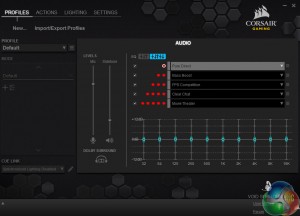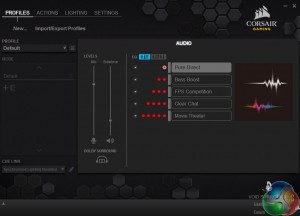Testing the Corsair Void involved me using it for a period of one week listening to hours of music, watching a selection of my favourite movies and for many long gaming sessions. Some of those were atmospheric, with haunting soundtracks, while others were more action packed, focusing on the immersive surround sound abilities of the Void.
All throughout testing I factored in its functionality, sound quality and overall comfort.
When it comes to gaming The Void was a very capable headset. It handles deep, rumbling explosions well and delivers a crisp soundscape that does not muddy various audio sources together. When testing it in titles like Subnautica, where the creeping, endless ocean has its own soundtrack of blips and bubbles, as well as distant roars – I found it perfectly capable of reproducing the haunting environment.
The surround sound elements also did an excellent job of immersing me in the environment. When I heard a bump on the back of my submarine, it sounded very much like that is where it came from, rather than sort-of behind my ear as you get with some headsets. This is doubly impressive because the Void is not a true surround sound headset. It might support Dolby 7.1, but it only features two 50mm drivers, so does not have the full soundscape of a real surround headset.
However, as with other brands we have tested in the past, that means that the over all audio quality is better because the fewer drivers generally means bigger and better drivers. The software enabled surround sound was good too, closely resembling the real deal in many respects. That goes for more explosive games too, letting you hear whistling bullets as they fly past your head, or explosions that you can practically feel scorching your back.
In games like Alien Isolation, the audio cues are great for building atmosphere and can also give you an idea of where the Xenomorph enemy is. It also enhances the overall experience to have a headset like this as it offers a better chance of survival.
When it comes to music playback, I was impressed. Bass can be deep and punchy and quite focused at the very bottom. There is a minor clarity dip at ultra high volumes with the lowest frequencies, but that is the only time you really notice the headset struggling to maintain composure.


Surround sound can be toggled on-off in the Corsair Utility Engine
Surround sound is not always welcome with music, as it does have the effect of cutting into the overall quality of the sound but that is easily adjusted in the back end software. You will also find there are quite a number of different pre-set EQ options. Pure-Direct, Bass Boost, FPS Competition, Clear Chat and Movie Theatre offer specific audio settings.
If none of them suit the tracks you are listening to or that particular game you are playing however, you can adjust them individually as well as create dedicated EQ pre-sets.
Much of the other settings in the Utility Engine software are redundant as they pertain to macro recording or lighting (of which this version of the Void headset has none). However I would like to see an option in future for an automatically chosen EQ when certain software is loaded up. That would be a nice addition to the back-end options.
Microphone quality for this headset is strong, if with a slight robotic twang added to your voice thanks to the noise-cancelling technology it incorporates. It is handy though, as I found music being played in other rooms did not show up at all in VOIP calls I made. There was some local noise pickup, such as clicking fingers or clapping within a metre of the headset, but even they were not that intrusive. A firm thumbs up for the noise cancelling.
The only feature on the Void which I could not get to work correctly was sidetone. That is the Utility Engine's command that lets you listen in to the microphone but for some reason I would never pick up my voice. It would however rustle when I blew on the mic, so something was getting picked up.
The Void headset was comfortable throughout all testing, with no ear fatigue or overheating – despite the over-the-ear design. Weight is distributed evenly between ears and headband, making the Void a supremely comfortable headset over long periods.
It is worth mentioning too that there was one feature I was unable to test during this review: the Corsair CUE visualiser system. This allows you to link up multiple Corsair peripherals together for unified light shows. For example, if you had a Corsair K70 RGB keyboard and the Void, you could have the lighting system on the board bounce along in time to your music. Likewise, the wireless Void headset can light up in-time with other Corsair peripherals.
 KitGuru KitGuru.net – Tech News | Hardware News | Hardware Reviews | IOS | Mobile | Gaming | Graphics Cards
KitGuru KitGuru.net – Tech News | Hardware News | Hardware Reviews | IOS | Mobile | Gaming | Graphics Cards



